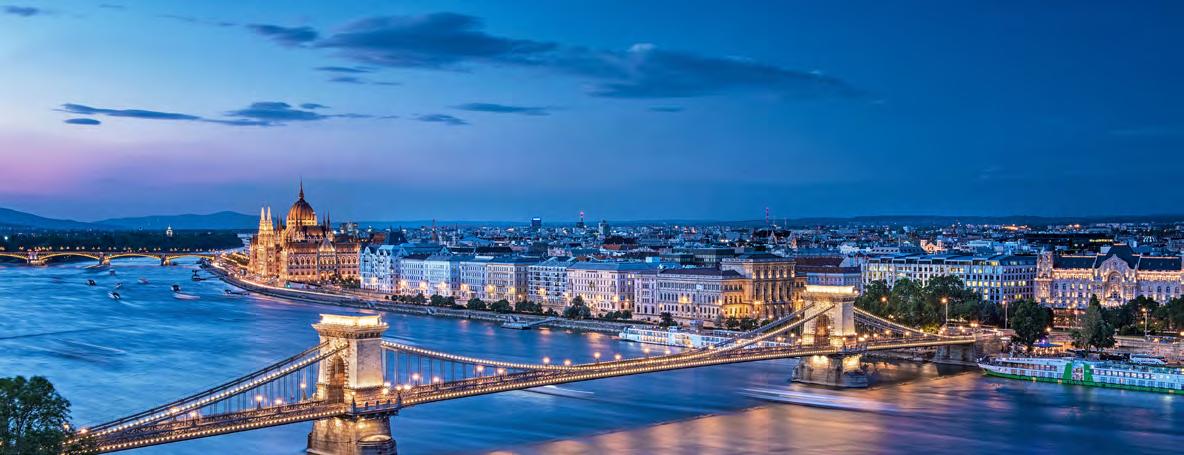EURASIA
New maps, new networks and new fusions characterise the new era marked by Eurasia


New maps, new networks and new fusions characterise the new era marked by Eurasia

We need to prepare for a new era
– Levente Horváth
GEURASIA
2-3.
The age of Eurasia is at hand
– Marcell Horváth
4. Why Russia needs China
– Alexandra Zoltai
THE ECONOMICS OF GEOGRAPHY
6-8.
Interconnectivity is reshaping the future: Interview with geographer Norbert Csizmadia
– Tamás Nánási-Kézdy
– Előd Bodnár
NEW SUSTAINABLE ECONOMICS
10-12.
The future with renewable energy – Laura Jókuthy
– Balázs Sárvári
13. Eurasia Forum
– top quotes
14-15.
The role of railways in the transport of goods in Asia
– Szabolcs Veres
16. Thailand, the destination for start-ups
– Péter Klemensits
2T2C: TALENT, TECHNOLOGY, CAPITAL, COGNITION
18-19.
Central bank digital currencies in the geopolitical dimension
– Luyi Pintér
20. Technological innovation in the Gulf countries
– Meszár Tárik CULTURE AND INNOVATION
21. Highlights of Eurasia
22-23.
MNB brings Hungarian contemporary art to Seoul and Abu Dhabi
24. 120 years of the Martian
26. Book reviews
27-28.
Opening to the East at the turn of the century: The Turanian idea
– Bálint Somkuti
29. In the footsteps of the Huns
– Ferenc Sinkovics
IN A MODERN WORLD
30-31. Tradition and modernity in eastern education
– Sándor Balogh
“Eurasia is also the location of most of the world's politically assertive and dynamic states…”
Zbigniew Brzezinski
We are witnessing, at the beginning of the 21st century, the emergence of a new world order. Many Western politicians, leading economists and prominent researchers tell us that this is Asia’s century. The centre of gravity of the world economy is pivoting to Asia and the era of Eurasia has already begun.
But what does this actually mean for us?
At the end of the Cold War, the United States was the only superpower left, and a unipolar world order was established. However, in the last two decades new economic areas and centres of power with global significance have emerged, primarily in Asia. China is the most obvious candidate to become a superpower alongside the US. Former US Secretary of State Henry Kissinger and former national security advisor Zbigniew Brzezinski saw the rise of China as the end of the unipolar world order. Both statesmen expressed the view that a multipolar world order would evolve after a long series of geopolitical conflicts in which Asia would gain an essential position.
Eurasia’s importance has increased since the 2000s. At the same time, a new multicentric world order is emerging in which the unity of Europe and Asia is taking on new meaning.
Levente Horváth, Ph.D., Director of the Eurasia Center, Editor-in-Chief of the Eurasia MagazineBritish historian Peter Frankopan is already writing about the emergence of a Eurasian supercontinent. According to Portuguese politician Bruno Maçães, the world map is being redrawn with the balance of power tipping eastwards, creating a new geographical entity, Eurasia, which stretches from Lisbon to Jakarta. Our fundamental objective is to introduce and present the Asian point of view as opposed to the single-sided Western news, and thus to find some sort of golden mean; quoting Seneca “ The other side shall be heard as well' or, in the wise words of the ancient Chinese strategist Sun Tzu : “...if you know the enemy and know yourself, you need not fear the result of a hundred battles”. Let us discover Asia and Eurasia.

THE EMERGENCE OF A MULTIPOLAR WORLD ORDER HAS BEEN ONE OF THE DETERMINING PROCESSES OF RECENT DECADES. IN ADDITION TO THE US AS A POWER CENTER, THE EURASIAN SUPERCONTINENT AS THE LARGEST LANDMASS ON EARTH AND ITS ECONOMIES, MOST NOTABLY CHINA, HAVE APPEARED AS CHALLENGERS.
China’s “return to the world stage” puts an end to the world order considered as customary for more than 300 years, in which the center of gravity of global governance and economy, and the dominant civilization model was provided solely by the Western World.

The close relationship between Europe and Asia is not new: the ancient Silk Road in China connected communities living on the supercontinent via the exchange of goods, knowledge, culture and technologies even before Christ. The Silk Road connected the centers of Eurasia: China, India, Persia, Arabia, Egypt and Rome. Until the rise of the US, the world’s power center moved about almost exclusively within Europe and Asia.
The center gradually shifted to Western Europe (the former periphery of the western core) from East and Southeast Asia, which had previously been more developed. The importance of the latter increased steadily from the 16th century as a result of the great geographical discoveries and the development of colonial empires backed by the western industrial and financial revolutions.
However today, in the era of a new fourth industrial and financial revolution, Asia is getting closer and closer to taking up a guiding role. The world’s economic center of gravity and the geopolitical force field have shifted eastwards again. According to projections, fast-growing developing countries (mostly in Asia) are expected to account for
up to 60 percent of global GDP by the middle of the century. In addition to being pioneers in innovation, Asian countries (especially China, South Korea, Singapore and the United Arab Emirates) are also leading the way in integrating innovations into society. Asia is not scared of technology. Asian countries adopt the latest solutions quickly and successfully, from mobile payments to robotics and synthetic biology.
Whether democratic or autocratic, rich or poor, one of the measures of a country’s success and competitiveness is the development level of technologies they use effectively and extensively and the extent to which their economic policies are innovation-based. So Asia not only bridges the gap, but also gains competitive advantage in making a giant leap forward through new technologies, their application as well as creative and innovative economic policies.


“At the dawn of a new era, a new Eurasian pole is forming around China with circles of influence spreading all the way to Europe.”
“Asian countries adopt the latest solutions quickly and successfully, from mobile payments to robotics and synthetic biology.”The author is the Executive Director of Magyar Nemzeti Bank (the central bank of Hungary) Photo: AFP/ XINHUA Xu Qin Photo: AFP/ Xinhua
Since Vladimir Putin became president of Russia and Xi Jinping became president of China, relations between the two countries have experienced a golden age, as evidenced by the fact that the two leaders have met face-to-face a total of 39 times until 2022.
Russia's earlier opening to Asia led to a spectacular expansion of economic ties with China, making China Russia's largest trading partner even before the war. Since the outbreak of the Russian-Ukrainian war, China, on the one hand, has been using the opportunity to buy energy sources at low prices from Russia, which is losing its Western markets, and, on the other hand, its companies have been trying to fill the gap left by the withdrawal of Western companies from the Russian market.

In addition to these benefits, Western sanctions against Moscow also provide Beijing with the opportu-
nity to increase the weight of its currency in trade with Russia. China has refused to condemn Russian aggression, instead repeatedly blaming NATO and the USA for the conflict and opposing sanctions.
China is taking advantage of the economic benefits arising from this situation but is also trying to push for a peace deal, as a peaceful international environment is essential for China's development and economic growth.
The author is a researcher at the Eurasia Center of John von Neumann University
"Russia's earlier opening to Asia led to a spectacular expansion of economic ties with China."Source: AFP/Anadolu Agency Yasin Demirci

“Today, the world is connected by 1 million kilometres of undersea internet cables, 2 million kilometres of pipelines, 4 million kilometres of railways and 64 million kilometres of roads.”
 Photo: Orsolya Egressy
Photo: Orsolya Egressy
NEW MAPS, NEW NETWORKS AND NEW FUSIONS CHARACTERISE THE NEW ERA MARKED BY EURASIA, AND THE MUCH MORE COMPLEX WORLD IN WHICH WE LIVE TODAY, SAYS GEOGRAPHER NORBERT CSIZMADIA, THE CHAIRMAN OF THE BOARD OF TRUSTEES OF THE PALLAS ATHÉNÉ DOMUS MERITI FOUNDATION AND THE JOHN VON NEUMANN UNIVERSITY FOUNDATION.
- We are increasingly talking about the emergence of a new supercontinent, Eurasia. Already in the 19th century, there were theories predicting the inevitable meeting and interconnection of Europe and Asia...
- The Eurasian world order is not a vision for the future, as it has already started in 2013. China has launched the New Silk Road initiative (or BRI, that is Belt and Road Initiative) to shift the axis of development from the seas to the land, establishing its former interconnected Eurasian importance, both economically and culturally. The New Silk Road connects the easternmost part of Asia with the westernmost points of Europe through various economic and trade corridors and infrastructure developments. But the New Silk Road is not only about logistics development, it is also about com-
mercial, cultural, digital, educational, green and health cooperation. This cooperation is much stronger than epidemics or armed conflicts could change it. The main reason for this is that our fastpaced world is now characterised by increasing interconnectivity, which was one of the key foundations for the creation of Eurasia.
“The interconnection and formation of the Eurasian supercontinent undoubtedly marks the end of the 500-year Atlantic era and the start of a new Eurasian era.”
- Why is this interconnectedness important?
- Today we have to look at processes at a much more complex level. The explosive development of interconnectedness, of connectivity, has fundamentally rewritten the way we have understood it so far. Today, the world is connected by 1 million kilometres of undersea internet cables, 2 million kilometres of pipelines, 4 million kilometres of railways and 64 million kilometres of roads. These lines may not be visible on traditional maps, but in many ways they are more important than the borders that separate countries. The infrastructure network connecting us all is of greater importance at transcontinental level.
- The study and theory of interconnectedness is essentially the brainchild of geopolitical analyst Parag Khanna. To what extent does this new approach override previous geographical approaches?
- Parag Khanna’s book is a groundbreaking, very exciting book. Its message is based on three pillars.
On the one hand, the author starts from the assertion that globalisation is making interconnectivity increasingly important. On the other hand, Khanna argues that geography needs to be rethought, and a functional approach needs to be introduced alongside natural and economic descriptions. The third claim of the book is that competitive interconnectivity is the most important geopolitical driver.

- Could the conflict between Ukraine and Russia be linked to the intensification of the Eurasian process?
- The interconnection and formation of the Eurasian supercontinent undoubtedly marks the end of the 500-year Atlantic era and the start of a new Eurasian era. Every change of era comes with a transition, and we are now part of it. It is already clear that a single-centred world is being replaced by a multi-centred one in the process of globalisation.

 By Laura Jókuthy – Balázs Sárvári
By Laura Jókuthy – Balázs Sárvári
ONE OF THE CHARACTERISTICS OF EURASIA'S DIVERSITY IS HOW SOME OF ITS LEADING POWERS TYPICALLY DO NOT POSSESS THE ENERGY RESOURCES THAT ARE SUITED TO THEIR STRATEGIC GOALS. FOR CHINA AND INDIA FOR EXAMPLE, MEETING ENERGY NEEDS IN THE FACE OF ECONOMIC DEVELOPMENT AND POPULATION GROWTH TRENDS IS A STRATEGIC ISSUE. THEIR POTENTIAL PROVIDES THEM WITH A STRONG INCENTIVE TO EXPLOIT RENEWABLE ENERGY SOURCES.

Asia has expanded its renewable electricity capacity at nearly double the rate of Europe over the past 11 years.

In December 2019, the European Commission unveiled the European Green Deal, and closely related to this, just a few months later, the EU made a legislative commitment to its 2018 pledge to achieve climate neutrality by 2050, the first in the world. 75 percent of the EU's greenhouse gas emissions are linked to the energy system.
Asia is not only the largest continent in size, but also home to 60 per cent of the world's population and, according to the World Bank’s 2019 data, 48 percent of global greenhouse gas emissions. What makes the situation a bit murkier is the fact that the

European Union has outsourced many of its high output industries to the Far East, where labour is much cheaper.
Shortly after the release of the European target figures China made an ambitious commitment in October 2020: They aim to be carbon neutral by 2060, while at COP26 in November 2021, India also announced plans to achieve carbon neutrality before 2070. Net zero emission targets have also been set by Japan, South Korea and six countries in SouthEast Asia. And the Sustainable Development Scenario (to keep global tempera-ture rise below 2 degrees Celsius under the Paris Agreement) outlines the key actions needed to achieve the target.
The race between Europe and Asia is far from over, but Asia (and East Asia in particular) has the advantage, based on the momentum of efforts in recent years.
Laura Jókuthy: The author is a senior analyst at Magyar Nemzeti Bank
Balázs Sárvári: The author is a senior researcher at Magyar Nemzeti Bank
Globally, transport carbon emissions account for about one quarter of energy-related emissions, and if unmitigated, are expected to grow 60 percent by 2050. Decarbonizing transport thus is a climate imperative but a challenging one at that, as Mari Pangestu, the Managing Director of the World Bank Group, recently wrote. At the heart of the challenge is rapid motorization, especially in middle-income countries – car ownership soars most rapidly when the per capita income ranges between $5,000-15,000. In China, there are currently fewer than 200 vehicles per 1,000 people, compared to about 600 in the European Union and over 800 in the United States.
China again leads the world in clean energy investments, having spent 546 billion USD in 2022 — nearly half of the world's total, according to market research firm Bloomberg NEF.Photo: AFP/He Huawen

When it comes to the level of technological development, the East has totally closed the gap which used to be there, compared to the level of development of the so-called West.
Péter Szijjártó Minister, Ministry of Foreign Affairs and Trade, HungaryWe must act now as a global community. We must accelerate the slow-moving transformations towards greater sustainability and equity.
Zhenmin Liu Chairman and Executive Director, China Construction BankWe have a minimum tripolar world system today.
Parag Khanna Bestseller Author, Expert of International Relations, GeopoliticsIN ADDITION TO AIR AND SEA FREIGHT, RAIL FREIGHT IS AN INCREASINGLY ATTRACTIVE WAY OF TRANSPORTING GOODS WITHIN ASIA AND BETWEEN CHINA AND EUROPE. THE MAIN ADVANTAGES OF RAIL TRANSPORT ARE SPEED, VOLUME AND COST.

The railway has become the simplest and still the most effective means of overcoming the huge distances in Asia and delivering products from one point to another. Asia's fast-growing economies are making significant investments in overland, mass goods and passenger transport in order to ensure the countries' economic growth and trade. The countries of Asia, led by China, are making significant investments in the development of transport infrastructure and strategies that promote sustainable transport.
Rail freight traffic within Asia and between Europe and Asia is also undergoing changes as a result of the established global power relations. The current situation in Asia has increased the value of the Central Trade Corridor spanning the Caspian Sea and the rail freight routes of this corridor. As a result, in the future Turkey may become one of the hubs of trans-Eurasian rail freight transport, which is strongly supported by the country's leadership.
Turkey is constantly making new infrastructure investments in the Kocaeli railway port. Meanwhile, the State Railways of the Republic of Turkey (TCDD) has completed the construction of the Kars Logistics Center, which is suitable for the coordination of railway lines with different gauges, on-site customs clearance and warehousing tasks.

The author is a researcher at the Eurasia Center of John von Neumann University
Thailand ushered in a new age of train travel on January 20 as Southeast Asia’s biggest railway station, the Krung Thep Aphiwat Central Terminal officially began operations, AP reported. The government says the huge, modern development on the edge of central Bangkok will bolster the country’s position as a regional hub and boost its economy, the news agency adds.
More and more experts believe that in the coming decades of the 21st century, the railway will be the most important, cost-effective and environmentally friendly driver of the economy in Asia, as a means of mass and fast transport of goods and passengers.Photo: AFP/ Xinhua Hu Chenhuan
AMONG SOUTHEAST ASIAN COUNTRIES, THAILAND IS IN MANY WAYS A FAVOURABLE PLACE FOR ENTREPRENEURS. NOT ONLY DOES SOCIETY SUPPORT ENTREPRENEURSHIP, BUT A LARGE PERCENTAGE OF PEOPLE ARE NOT AFRAID TO TAKE ENTREPRENEURIAL RISKS.




Thailand has a thriving ecosystem for start-ups, boosted by key factors such as geographic location, access to sea lanes with modernised ports, low inflation rates, and availability of low-cost skilled labour.
By 2022, there were over 1,000 start-ups in Thailand, including foreigners, which is about one startup per 70,000 people.
Most start-ups in Thailand today are in fintech, while the second most lucrative start-up sector is food processing and technology, while start-ups in
health-tech, industry-tech, travel-tech, ed-tech, agtech or business service are also numerous.



They use their expertise in finding niches, adapting the product to the market, solving problems and working symbiotically with Thai companies and foreign affiliates in Thailand.

Our International Economy and Business program is among Hungary’s most popular MSc programs
Establishing the MNB Knowledge Center and renewing the International Economy and Business Master's program at John von Neumann University were the two most important pillars of the cooperation between the Magyar Nemzeti Bank and the University. After a comprehensive renewing of the MSc program by the MNB Institute, this program provides a unique and competitive knowledge for the students in Hungary.
MNB Institute, this program provides a unique and competitive knowledge for














Our renewed MSc program even in its first year attracted more than 3 times as many applicants as the planned quota.
The MNB Institute welcomes its students from September with internationally well-known professors, innovative and professionally outstanding courses, the professional support of the Magyar Nemzeti Bank and unique talent management programs.



mnbintezet.hu/oktatas












CAN WE EXPECT A GEOPOLITICAL SHIFT IN FAVOUR OF CERTAIN REGIONS AND COUNTRIES THANKS TO DIGITAL CENTRAL BANK CURRENCY (CBDC)? THE RISE OF NEW CENTRES OF POWER REQUIRES A NEW FINANCIAL SYSTEM. AND FINANCIAL TECHNOLOGICAL BREAKTHROUGHS ARE NOT WITHOUT GEOPOLITICAL CONSEQUENCES.
Today, more and more countries are launching CBDC research & development and testing projects. The countries involved in CBDC development together now account for nearly 95 percent of world GDP (according to the Atlantic Council).
China is the first major economy to have made significant practical progress: since 2020, e-CNY (digital yuan) has been tested in real-world cash flows in several metropolises. In addition, e-CNY could of course also stimulate the international use of the yuan, and the real geopolitical prospects lie in this.
One of the cornerstones of the role of the US and the Atlantic powerhouse in the current world order is the function of the dollar as the world currency. China offers a new alternative based on mutual benefit, which can be joined without any special economic or foreign policy conditions in the framework of the New Silk Road. And with the power advantages thus gained, China and the e-CNY would emerge as the most serious challenger to the US power position in a long time.
The author is an international adviser at Magyar Nemzeti Bank (the central bank of Hungary)
“China’s digital yuan can be used by everyday Chinese people through existing, and very popular, digital payment services like Alipay and WeChat Pay”, the Wall Street Journal writes. “India’s digital rupee is an equally bold experiment in allowing the country’s citizens to transact with a digital version of their currency in a way that could bypass traditional banks”, it adds.

“Whoever is first in the field and awaits the coming of the enemy, will be fresh for the fight; whoever is second in the field and has to hasten to battle will arrive exhausted. Therefore the clever combatant imposes his will on the enemy, but does not allow the enemy’s will to be imposed on him”
- Sun TzuPhoto: iStock
Companies in the six Gulf Cooperation Council (GCC) states (Kuwait, Bahrain, Qatar, United Arab Emirates, Oman and Saudi Arabia) are increasingly looking to adopt innovative technologies to help them build new business models and deliver modern customer experiences. The following is a non-exhaustive list of the most significant projects.
The SPARK project is a sustainable global energy hub that embodies an integrated global industrial city. It aims to become a regional gateway for energy sector logistics, a business incubator model, attract foreign investment and provide jobs within the Saudi energy transition, sustainability and climate support project.
The Abu Dhabi-Dubai route has become a focal point for Hyperloop developers. The project aims to make the journey between the two cities in just 12 minutes.

The world's greenest eco-resort is being built around a natural spring using a range of green technologies in Liwa, in the south of the United Arab Emirates.
Dubai's mega solar park
Dubai could become a green powerhouse in the coming decades thanks to a mega-park that should generate 5,000 megawatts by 2030, when construction is complete.
Self-driving police cars in the United Arab Emirates
These self-driving cars can deploy drones if a criminal is detected. The authorities want to put these cars on the streets as part of a technology-enabled police force.
Zain Bahrain, one of the kingdom's leading telecoms operators, has partnered with Ericsson to introduce the "most innovative Internet of Things (IoT) technology". With the introduction of this technology, businesses and consumers can achieve broader wireless coverage, better connectivity, longer battery life and cost-effective solutions.
As part of the Vision 2035 strategy, the Kuwaiti government is building a "smart city". Touted as the Middle East's first green, smart technology-focused development, the billion-dollar project will eventually be home to 400,000 people.
The author is a researcher at the Eurasia Center of John von Neumann University
IN THE FOLLOWING ISSUES WE PRESENT THE BEST OF EURASIA'S TOURIST DESTINATIONS





A selection of contemporary art from the collection of the Magyar Nemzeti Bank (MNB), Hungary’s central bank was shown at the Etihad Modern Art Gallery in Abu Dhabi between 14 November and 4 December last year. The exhibition was examining the connection between writing and image in Hungarian contemporary painting, titled Picto/graphy: Calligraphies, Signs, Gestures and Letter Images.
It presented twelve prominent Hungarian artists who are well-known and recognized on the Hungarian and international art scene. Many of them are leading figures of the Hungarian neo avant-garde (1960s and 70s), including artists who lived abroad (in France, Germany or Asia) and who are, associated with Simon Hantaï's surrealist-calligraphic painting, the pieces which were the closure material of the Louvre Abu-Dhabi. The exhibition is organized by MNB Arts and Culture, the cultural branch of the MNB.
A rich selection from the MNB’s new collection was presented at the Sungkok Art Museum in Seoul between 27 August and 15 October last year. The first major exhibition of Hungarian abstract art in Korea, Folded-Unfolded introduced the work of fifteen influential Hungarian artists who defiantly created abstract paintings and films from behind the Iron Curtain during the 1960s, 70s, and 80s.
Photo: Márton Orosz Imre Bak, Self-Image II., 2017, acrylic on canvas, 210x140 cm, Courtesy of MNB Arts and CultureIlona Keserü Ilona (1933–), Stream, 1975-1989


Acrylic,
MNB Arts & Culture maintains the contemporary art collection launched by the Magyar Nemzeti Bank (MNB), Hungary’s central bank. The collection's contemporary material was digitised during the pandemic and made available to the public in virtual space www.mnbarts.hu



Tempera,


Publisher: Pallas Athéné
Publication date: 2022
ISBN: 978-963-573-160-2
Pages: 184
György Matolcsy, Governor of Magyar Nemzeti Bank, the central bank of Hungary shares his insights in response to articles published in globally renowned journals by the top economists, scientific experts and opinion leaders of our time. They point the way towards not only long-term sustainable and viable systems, but also a completely new way of thinking. He invites the reader to regard the world economy as a complex living system where cycles, patterns and fractals work together and the rules of the Quantum World are the Power Laws. The author challenges all the extremes of liberal economic thinking in order to accelerate the transition to a sustainable global economy based on new sustainable economics. All his arguments can be summarized in the title of the book: we live on the edge of times, where the “50-year” and “80-year” cycles tend to shape the 2020s, our time.

Publisher: Oxford University Press
Year of publication: 2020
ISBN: 978-0190914974
Number of pages: 352
The book scrutinizes Southeast Asia as a collision zone between the two great powers, China and the United States. The author analyses the opportunities open to Beijing and Washington and what legacies each power’s long history of interactions with the region bear. It also examines how the ten member countries of the Association of Southeast Asian Nations (ASEAN) relate to the United States and China and how they manoeuvre between the two powers, as well as what the future may bring in terms of their emerging rivalry. Due to its highly readable and at the same time technical character, this book may be useful for both regular and professional readers, who can obtain very useful information on the complex regional presence of the US and China. The author has a PhD in political science and is a professor at George Washington University.
KNOWLEDGE
COMMUNITY
International scientific and professional bestsellers in Hungarian and books with powerful thoughts from Hungary
A selection of our volumes:
GYÖRGY MATOLCSY On the Edge of Times

The Rerun of the 1940s and the 1970s
SANDOR P VACI
An English Dimension The diaries of the Hungarian Count István Széchenyi, 1832-1834

ENDRE DOMONKOS
An Economic History of Hungary from 1867

NORBERT CSIZMADIA
Geofusion 2.0

The Power of Geography in the Economic and Geopolitical World Order
PallasAtheneKiado
Pallas Athéné Könyvkiadó
pallasathenekiado
pabookstore
On the occasion of the 120th anniversary of the birth of John von Neumann, the Jon von Neumann University in Kecskemét and the John von Neumann University Foundation launched the Neumann 2023 programme series.

The extraordinary scientist, often called "the Martian" because of his outstanding abilities, was voted one of the smartest men of the 20th century. To mark the 120th anniversary of his birth in 2023, several organisations dedicated to the memory of the world-famous mathematician, including the John von Neumann Computer Science Society and the university have declared 2023 as the year of commemoration. The country's most dynamically developing university has borne Neumann's name since 1 August 2017.
In his honour, the university is organising 36 major events as part of the Neumann 2023 pro -
gramme year. In addition to scientific conferences and academic competitions, a wide range of cultural programmes and exhibitions will draw attention to the intellectual and scientific work of John von Neumann.
"As part of Neumann 2023, we would like to invite speakers from South Korea, Singapore, the United Arab Emirates and other countries. We will organise an international sustainability conference in June and the Neumann TEDX in the autumn. We will also organise exhibitions, competitions and many exciting professional programmes on technology, vehicle manufacturing, sustainability, talent and knowledge, from sustainable economics to future transport," Norbert Csizmadia, Chairman of the Board of Trustees of the John von Neumann University Foundation told Magyar Nemzet.
 By Bálint Somkuti
By Bálint Somkuti
THE EASTERN, NOMADIC ORIGINS OF HUNGARIANS HAVE HAD A SIGNIFICANT IMPACT ON OUR NATIONAL IDENTITY. THE DEBATE ABOUT HUNGARY’S GEOPOLITICAL FEATURES, ACTING AS A BRIDGE OR FRONTIER, CAME TO THE FOREFRONT DURING THE TIME OF THE AUSTRO-HUNGARIAN DUAL MONARCHY (1867-1918).
Turanism, which promotes eastern orientation as opposed to western trends, has played an important role in Hungarian public discourse since the turn of the 19th and 20th centuries. For some, the East and “opening to the east” extended only to the Balkans. Others imagined the past and the future in cooperation with the Middle East and the Ottoman Turkish Empire.
The first Hungarian expeditions to the East around the end of the 19th century were financed and led by aristocrats who endeavoured to research

the geography, fauna, flora, ethnography, archaeological monu ments and languages of Asia. The Turanian Association, which was supported by the political and economic elite of the Kingdom of Hungary, was founded in December 1910 under an illustrious leadership. When it was registered, it was also given the illustrious name “The Hungarian Asiatic Society”. The board of chairmen included prominent members such as the honorary chairman Ármin Vámbéry and the later Prime Minister Pál Teleki, who was an elected chairman. The monthly journal of the association was the Turán. The declared objectives of the association included the strengthening and development of economic relations with the so-called “Eastern” countries (Asia and the Balkans) as well as “achieving a leading role for Hungary in the Turanian family of nations in scientific and economic areas”.

THANKS TO THE DEVELOPMENT OF TECHNOLOGY, ARCHAEOGENETICS AND THE PERSEVERANCE OF SOME ARCHAEOLOGISTS AND HISTORIANS, IT IS NO LONGER A MYTH TO BE LAUGHED AT, BUT A HISTORICAL FACT THAT HAS BEEN PROVEN IN MANY WAYS: HUNGARIANS ARE THE DESCENDANTS OF THE HUNS.
Many accounts record that the Huns had ore mines, metal workshops, industrial plants, were skilled in agriculture, and even engaged in advanced trade.
Miklós Makoldi points out that, the Chinese, for instance, were taught by the ancestors of the Huns, the eastward-moving horse-riding peoples of the Steppe, the art of bronze casting. Owing to this reason, the Copper Age is missing from China’s history, since, having mastered the more sophisticated bronze-casting techniques, they simply skipped this step, only to further develop the art of bronze-working to a fairly high level indeed.
Source: iStock
The excavation carried out by the Mongolian Academy of Sciences and the Institute of Hungarian Research (MKI) in Ar Gunt last year has produced some sensational results. Forty Hun graves have been identified so far in this Mongolian cemetery, seven of which were been opened and examined in the first half of last year.
The excavation revealed that the seven Ar Gunt tombs are no poorer than the larger, square Hun tombs. According to Miklós Makoldi, Director of Archaeology at the MKI, it is not wealth but the date of origin that distinguishes the smaller, round tombs from the larger, square ones. The tombs recently excavated by the Hungarians are estimated to have been created between the 5th century BC and the 2nd century AD.

PRIMARY AND SECONDARY EDUCATION IN ASIA HAS UNDERGONE A MAJOR TRANSFORMATION IN THE RECENT YEARS. THE PANDEMIC HAS REINFORCED ’EXISTING’ TRENDS, IN PARTICULAR DIGITALISATION, AND RECENT INNOVATIONS IN EDUCATION ARE EXPECTED TO CONTINUE IN THE LONGER TERM.
In Asian countries with strong economic success, it is very difficult to imagine an existence without a degree, so knowledge is a key asset. The East has a long tradition of respect for knowledge, and for centuries the elite of society have been selected through extremely rigorous examinations.
Many therefore believe that this tradition is the main reason for success. In the Asian tradition of education, external factors are less important for children than the progress made in the school system and the academic achievements and examinations taken, which later lay the foundations for the young adult’s social status and individual excellence.
The emphasis on academic achievement means that in Asian countries children spend almost all day in school. The teachers are well-dressed, well-paid, exemplary people who devote their whole life to teaching. The schools are well-equipped and well-provided with infrastructure, and both traditional and digital tools have their place in Asian schools.
One of the most effective methods of educating the current generations is project-based pedagogy, which is complemented by a varied assessment system and can produce results that students can also use in the world of work.

The shift to digital has become the order of the era. In Singapore and Hong Kong, schools are constantly being upgraded to provide students with the latest technology. Hong Kong, Singapore, Japan and South Korea are working to integrate the achievements of the 21st century.
The author is a project adviser at Magyar Nemzeti Bank (the central bank of Hungary)
Eastern systems often instil moral value in education. In China in particular, students follow the learning tradition founded by Confucius, who emphasized the vital role of education in bringing honour to one’s self, family and society. As cited by Jin Li, writer of the book, “Cultural Foundations of Learning: East and West,” students who operate under this moral code believe that learning is the most important thing in life and that it is life’s purpose. The journey towards knowledge is essential in gaining resolve, diligence and requires steadfastness, concentration and humility. (Source: Borgen Magazine)
 Photo: iStock
Photo: iStock
HU ISSN 2939-8789
Published by Neumann Lapkiadó
és Kommunikációs Kft.
Publisher's Headquarters: 1117 Budapest, Hungary, Infopark sétány 1.
Responsible Publisher:
Levente Horváth, Ph.D., Managing Director
Editor-in-Chief: Levente Horváth, Ph.D.
Managing Editor: Mariann Őry, Péter Petán
Text Editor: Erika Koskocki
Editors: Loretta Tóth, Gabriella Viland
Photo Editor: Róbert Hegedüs
Graphic Design and Layout: Alexandra Érsek-Csanádi, Anita Kónya
Eurasia Magazine Online Editorial Board
Members:
Ágnes Bernek, Ph.D., László Csicsmann, Ph.D., Norbert Csizmadia, Ph.D., Mózes Csoma, Ph.D., Prof. Zoltán Dövényi, Ph.D., Béla Háda, Ph.D., Prof. Imre Hamar, Ph.D., Eric Hendriks Ph.D., Prof. Judit Hidasi, Ph.D., Dr. Máté Ittzés, Ph.D., Péter Klemensits, Ph.D., Kristóf Lehmann, Ph.D., Csaba Moldicz, Ph.D., Prof. Erzsébet N. Rózsa, Ph.D., Borbála Obrusánszky, Ph.D., Prof. József Popp, Ph.D., Sándor P. Szabó, Ph.D., Prof. Zsolt Rostoványi, Ph.D., Gergely Salát, Ph.D., Péter Szatmári, Ph.D., István Szerdahelyi, Ph.D., Prof. István Szilágyi, Ph.D., Prof. István Tarrósy, Ph.D., Prof. István Tózsa Ph.D., Prof. László Vasa Ph.D., Zoltán Wilhelm, Ph.D., Alexandra Zoltai
Copyright :
All rights of use of the databases of Eurasia Magazine Online are granted to the Neumann Lapkiadó és Kommunikációs Kft. The written material and photographs used on this website are protected by copyright. They may not be published, broadcast or transmitted in any form or by any means, or stored in whole or in part on a computer, whether in their original or transcribed form.
“
The natural geopolitical arrangement is for Europe to be part of Eurasia.”
Michael Hudson
The South China Sea functions as the throat of the Western Pacific and Indian oceans - the mass of connective economic tissue where global sea routes coalesce. Here is the heart of Eurasia's navigable rimland, punctuated by the Malacca, Sunda, Lombok, and Makassar straits.

